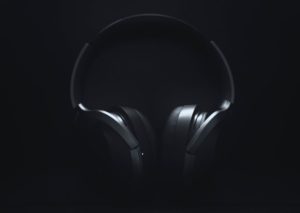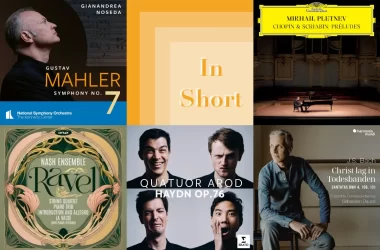Updated with new recordings: January 3, 2025. Originally published: September 2018.
We continue our “Best Of Classical Music Guides“, in this case dedicated to Bach’s Goldberg Variations, this time choosing the best recordings played on the piano. See below the previous parts (Part I, Part II).
Part 3 – The Piano
Playing Bach’s Goldberg Variations on the piano presents enormous challenges; the additional possibilities this instrument offers compared to the harpsichord can sometimes feel like an obstacle rather than an advantage. As covered in the first part of this guide, Bach left very few instructions regarding tempo and phrasing in the score, leaving them to the performer’s discretion.
On the piano, however, a crucial element is missing – the double keyboard functionality. As discussed in the second part, which recommends the best harpsichord recordings, some variations instruct the performer to use two manuals (i.e., two keyboards). In other cases, performers can double the notes by activating a mechanism that allows playing on one keyboard while operating both simultaneously.
A common solution is to differentiate dynamics, playing some passages forte and others pianissimo, but this often falls short of fully capturing the composer’s intent. Additionally, baroque ornaments that sound appropriate or even “natural” on the harpsichord can lose effectiveness or disrupt the musical flow on the piano. Some pianists navigate these challenges masterfully, while others are less successful.
Rudolf Serkin made a piano roll take on the variations, and it was later adapted to modern pianos and recorded as an original performance. It may show us some musical intent from this well-respected pianist, but it’s hardly a full image of how Serkin might have performed the piece.
The first real, full piano version of the Goldberg Variations was probably made by the great Chilean pianist, Claudio Arrau, in 1942. Luckily, the rise of classical music streaming services has brought it back to the catalog. Upon first listen, it’s rather surprising how “modern” this performance sounds, with hints of 19th-century romanticism that appear in other early Bach studio recordings and consistent tempo choices that sustain the performance’s flow from start to finish. All of Arrau’s hallmarks are omnipresent, including his sometimes rigid handling of fast-paced elements or his tendency to slow down and emphasize “depth of feeling.” This is an impressive document, and the mono recording is rather good for its age.
Another pioneering Goldberg Variations recording was made in the same period by Eunice Norton, along with other attempts by this lesser-known American pianist. It’s a fine performance but relatively hard to come by. It occasionally appears on YouTube for those curious to hear it.
Here Comes The Canadian Superstar
But let us talk about the big grand piano in the room – Glenn Gould.
Gould’s 1955 mono recording of the variations revived interest in the piece, becoming a huge commercial success and bringing lasting fame to the Canadian pianist until the end of his short life. It’s one of the most iconic records in classical music history and deserves a place in every collection.
However, judging Gould’s performance solely on musical grounds, it’s not necessarily one of the best versions of the Goldberg Variations. As with most (if not all) of Gould’s recordings, there are intentional oddities—some of which are plainly nonsensical—including unnatural phrasing, exaggerated staccatos, and excessively fast or slow tempo choices. The entire performance feels rushed, not allowing the music time to breathe or leave an impression of its own (Gould’s decision not to play a single repeat contributes to this). Still, the charm and excitement of this 1955 recording are undeniable. The original recording, which was rather dry and limited in dynamic range, has been re-engineered and remastered multiple times. This includes producing a stereo version by re-recording on a new piano (Zemph) and remastering from the original commercial LP (Naxos). In my opinion, Sony Music’s 2013 remastering is the best sounding to date and includes Gould’s later 1981 interpretation.
Gould’s digital 1981 version is equally fascinating and, like his 1955 mono recording, belongs in any record collection. The approach is different from the earlier version, marked by an almost ideological consistency of rhythm from the first note to the last. This results in a highly uniform listening experience, though it again introduces some peculiar tempo choices. Gould does choose to repeat certain variations when he feels he has something new to express the second time. His interpretation of Bach remains enigmatic—for better or worse—and his characteristic vocalizations can be distracting during the performance. Gould recorded the piece over a short period and spent several months editing it in the studio. The final result is captivating, continuing to spark controversy and demanding to be heard.
Rosalyn Tureck, another great Bach pioneer, recorded the Goldberg Variations many times—on piano and harpsichord, both live and in the studio. She has her own group of admirers, and given her distinguished scholarly and pianistic career, this is justifiably so. Her style, however, hasn’t entirely stood the test of time, especially in light of the evolving understanding of Bach performance over the past few decades. Tureck clearly views the Goldberg Variations as a monumental work, on par with the St. Matthew Passion or the B Minor Mass. This sense of scale is reflected not only in the broad tempi she adopts but also in the overall weight of her interpretation. There’s a certain heaviness to her playing, accompanied by a didactic directness that highlights every interpretative decision and ornamentation—an area in which she was a true academic expert.
Unfortunately, there is no single definitive version of the Goldberg Variations by Tureck, as each recording presents its own strengths and weaknesses. Her 1957 Abbey Road Studio mono recording captures her at her slowest and most articulated. A later 1980s recording on the VAI label likely represents her at her absolute best—relatively free and flowing—but the performance is hampered by the amateurish quality of a private concert recording. Her later digital release on Deutsche Grammophon (1999) offers the best technical sound, though by then, in her mid-eighties, Tureck lacked the focus and technical command of her younger years. Additional live performances are available, and fans of Tureck are encouraged to explore and select their preferred version through careful listening.
Late 60’s Wave
What is most special about Wilhelm Kempff’s recording (DG, 1969) is his determination to strip the score of any ornament, leaving the bare minimum of the music (listen to the aria – you’re in for a shock). He also, for some reason, chooses to repeat only the first part of most of the variations, playing a single take on the second part. However, you can’t deny that a great artist is at work, and Kempff’s unmistakable sound and authority are clearly projected in this recording. Despite its oddities, it’s a compelling version.
Charles Rosen’s version (Sony, 1969) is effective, calm, assured—perhaps too “ordinary” and lacking in standout moments. This is another severe, serious interpretation, but one that flows more naturally and effortlessly than Tureck’s.
This period also saw a recording by Maria Yudina (Melodia, 1968)—a fascinating document and worth listening to if you want to familiarize yourself with this unique artist, often referred to as “the Russian Glenn Gould.” However, it can hardly be considered one of the best versions.
Tatiana Nikolaeva first recorded the piece in the late 1970s for the Melodia label, one of several live and studio recordings by this great Russian artist. Availability of some of these recordings is limited, making it difficult to recommend a definitive version for Nikolaeva’s admirers. The available recordings showcase Nikolayeva as a mesmerizing, romantic Bach interpreter—perhaps not to everyone’s taste but undoubtedly enjoyable.
Rare Yet Significant
Despite the boom of harpsichord recordings in the 1980s and the hype surrounding Gould’s later version, piano recordings of the piece still remained relatively rare.
András Schiff’s first recording of the piece for Decca (1983) still stands out; Schiff brings a distinct sound and personal approach to Bach (and other composers). His phrasing can be described as “declaratory,” or as Schiff himself calls it, “Parlando” – in a speaking manner. He avoids imitating the harpsichord, delivering a pianistic account in the best sense. This early version already reveals him as a highly individual artist, ornamenting repeats with fascinating detail and projecting a clear vision of the piece as a whole, while mastering even the smallest contrapuntal elements (see variation 4 for a masterful contrapuntal performance). Some of Schiff’s experiments during this period, such as register shifts, verge on the comical (notably in variation 7). Schiff went on to record Bach’s complete keyboard repertoire for Decca in the following years, but this Goldberg Variations remains one of the highlights of the cycle.
Nearly 20 years later, with full Bach, Mozart, and Schubert cycles behind him, Schiff re-recorded the piece for ECM—an outstanding live version from Basel. This interpretation reflects greater maturity without losing any of the spontaneity, wonder, and fascination of the original. The sustaining pedal is almost entirely avoided, instead utilizing the hall’s acoustics to create a cantabile effect. This results in greater clarity in the contrapuntal writing and more playful ornaments during the repeats—now even bolder than in the Decca version. From a technical standpoint, this is one of the finest recordings in terms of sound quality.
Schiff’s Bach is not steeped in sacred weight; virtuosity and dance-like elements are explored thoroughly, while maintaining a cohesive sense of the whole. The only lingering question is whether the listener will appreciate Schiff’s declaratory phrasing. Some will embrace it; others may not.
Around the same period, a less successful attempt came from a distinguished artist clearly out of his element. Alexis Weissenberg (1981, EMI-Warner) offers a version that can best be described as ill-suited to Bach’s style, marked by fluctuating tempos, awkward ornamentation, exaggerated dynamics, and heavy-handed playing. His hurried approach to the end of each variation further detracts from the performance. This rendition bears little resemblance to the brilliance often found in Weissenberg’s other recordings.
Maria Tipo’s late-1980s take on the variations (EMI-Warner) is commendable for its delicate voice coloring and intricate pedal work. However, she opts to repeat only the first part of the aria and variations, and at times introduces a sense of anachronism—doubling the basses in a way reminiscent of a Busoni adaptation.
Daniel Barenboim’s live Goldberg Variations (1989, Teldec) reflects wisdom and some appealing personal touches, reminiscent of his early Beethoven Piano Sonatas for EMI. His version features some debatable tempo and dynamic decisions. All repeats are observed, with nuanced adjustments primarily in dynamics and the highlighting of hidden voices. Barenboim’s approach treats each variation almost as a standalone piece, often with long pauses in between. While interesting and well-recorded (albeit closely miked), this interpretation is intriguing but unlikely to be a top choice.
Join The Classical Newsletter
Get weekly updates from The Classic Review delivered straight to your inbox.
Andrew Rangell’s newly re-released version of the Goldberg Variations for the Steinway & Sons label is so idiosyncratic—almost outrageous—that it demands attention. Whether it leaves you rattled, amused, or frustrated, it is certainly never dull.
Another version for adventurous listeners comes from Vladimir Feltsman, whose extravagant interpretation takes perhaps one too many liberties in pursuit of making the variations “interesting” at all costs. Excessive octave doubling, register changes, and non-legato, Gould-like phrasing abound—though without the guiding hand of the Canadian mastermind.
Goldberg On A Budget
In its early years, the Naxos label faced snobbish treatment from established music outlets and sections of the classical music community. This was largely due to the label’s commitment to budget pricing, often hiring lesser-known artists from Eastern Europe and Asia while sacrificing elaborate artwork and expensive promotional campaigns. This may explain why Pi-hsien Chen’s impressive 1988 recording of the Goldberg Variations hasn’t received the attention it deserves. At the super-budget price for which it was once available, the performance offered remarkable value—an assured, well-recorded, and technically commanding interpretation, with some charming individual touches. There is an appealing rhythmic consistency throughout, which paradoxically enhances the quieter, slower variations (such as variations 21 and 25), making them especially moving. However, the performance carries a somewhat “middle of the road” quality, with many repeats (few of which are observed) lacking fresh interpretative exploration. Additionally, some ornaments reflect a lack of historical awareness, with trills executed ahead of the beat.
Disappointingly, Chen’s 2001 rerecording at Teldec Studio in Berlin took an opposite approach regarding repeats, ornamentation, and interpretative freedom—resulting in a performance that feels forced and unnatural.
On the same label, Jenő Jandó, who recorded nearly all the major piano repertoire for Naxos, delivered a version that highlights his technical proficiency. Jandó’s performance of The Well-Tempered Clavier Book II, released a few years prior to his Goldberg Variations, came as a pleasant surprise, presenting him as a direct and assured interpreter of Bach. Unfortunately, his Goldberg Variations do not achieve the same artistic distinction.
The “Sleeper” Version
Listening blindly to Ekaterina Dershavina’s 1994 account, one might believe they are in the presence of a truly great Bach interpreter. Her performance captivates with its naïve, unassuming, and modest approach. Never excessive, her simplified playing manages to move the listener through its purity. The long journey through the variations—where she observes all repeats—is carried by a beautiful singing tone and subtle, appropriate ornamentation. Moments of emotional intensity arise when needed, such as in variation 21, while variation 25, the “black pearl,” benefits from tender flexibility.
The only notable drawback is the rather dry recording quality, but the artistic integrity of the performance quickly compensates for this. As of 2025, this recording is unfortunately hard to come by, with no availability on major streaming platforms. However, if the opportunity arises to obtain a copy, it is well worth the effort.
After a long absence from the recording studio, Dershavina has returned with new releases on the German Hänssler label, including albums of Bach’s French Suites and Medtner’s solo and chamber works—each well-received. Perhaps she will one day grace us with a better-recorded version of the Goldbergs. Until then, this remains a highly enjoyable and impressive interpretation.
Well Planned, Spontaneously Executed
Dershavina’s countryman Andrei Gavrilov recorded the piece for Deutsche Grammophon in 1994. Gavrilov is a truly fascinating pianist, employing all the tools at his disposal to illuminate this masterpiece. There are impressive technical feats (variation 5), nuanced ornament voicing (variation 7), and a genuinely cantabile approach (variation 9). However, there are also missteps—some variations appear to suffer from questionable tempo choices made in pursuit of rhythmic consistency, leading to a frantic variation 13 or sluggish takes on variations 15 and 21. The “black pearl” variation is one of the longest on record, losing much of the momentum built earlier in the performance. This is a recording worth hearing, but not among the finest interpretations.
Angela Hewitt’s first recording (1999) is notable for its clarity, beautiful tone, and intelligent tempo choices. She draws inspiration from the best qualities of past Bach interpreters (some mentioned above) while maintaining a distinctive personal voice. Her approach to repeats remains somewhat controversial; rather than ornamenting elaborately, she introduces variations in phrasing, voicing, and dynamics. Hewitt’s playing is unapologetically pianistic, incorporating crescendos and diminuendos that were unavailable on Bach’s instruments, though she uses the sustaining pedal sparingly. The primary shortcoming of this release is a slight lack of spontaneity—everything feels meticulously planned and executed, even in passages that deviate from the written text. Compare, for example, variations 15 and 20 to András Schiff’s interpretations; Schiff infuses emotional intensity without exaggeration, while Hewitt, though polished and elegant, falls short of leaving a lasting impression.
In 2015, Hewitt rerecorded the piece for Hyperion. As with her other second recordings for the label (notably The Well-Tempered Clavier), there is a sense of greater freedom and purpose. This can partly be attributed to her instrument of choice—a well-defined, evenly tuned Fazioli 308 piano. All the strengths of the original recording remain, and while this performance is still highly structured, it offers a clearer projection of musical ideas and benefits from superior sound quality. Hewitt’s interpretation of the “black pearl” variation now carries greater emotional weight, making it a highlight of the recording. For Hewitt enthusiasts, this second version is the definitive choice.
Evgeny Koroliov begins the Goldberg Variations in a rather uninspired manner, but the performance gains momentum during the first half of the set. Unfortunately, his approach to repeats can feel intrusive, causing the overall flow to wane in the latter half. While the recording quality is acceptable, it falls short of the highest standards. Koroliov’s habit of singing along—while not entirely unique—detracts from the experience, and the performance does not sufficiently compensate for this distraction.
Then came Murray Perahia, with his Gramophone Award-winning performance for Sony (2000). As with many exceptional recordings, it is difficult to articulate how Perahia achieves his results or imagine the piece played differently. His interpretation evokes a sense of exploration, navigating the Goldberg Variations as if traversing the full spectrum of human emotion. There is a palpable sense of direction, with the exuberance of the early variations giving way to the introspection of the later ones. The transition from the exquisitely rendered variation 25 to variation 26 can only be described as a moment of musical resurrection.
This rendition seems to embody everything—spiritual depth, technical mastery, a profound sense of structure and harmonic balance, and meticulous voice leading, all sprinkled with a touch of playfulness. The only minor drawback is the faint sound of fingernails striking the keys in the early variations, most noticeable in variation 3.
Perahia went on to record several more Bach albums for Sony and later Deutsche Grammophon, yet he never surpassed the achievement of this recording. It stands as one of his finest works—and indeed, one of the greatest piano recordings of Bach’s music. This interpretation deserves a place in every collection, offering a lifetime of enjoyment.
Getting Serious, Remaining Playful
It’s best to set aside the “Cinderella” story behind Simone Dinnerstein’s release—a self-funded recording later picked up by a major label—and listen to the performance with fresh ears. And it’s a fine version. Dinnerstein’s interpretation of Bach is mellow, reflective, quiet, and almost meditative. This recording distinguishes itself through its consistent approach. While it may not resonate with every listener, I find it highly persuasive. Dinnerstein’s performance rewards attentive listening, revealing subtle intricacies over time. It’s one of those recordings that demands patience—and deserves it.
Joanna MacGregor’s restless interpretation has one particularly memorable moment—the Aria da Capo at the end, where the final variation echoes seamlessly into the return of the opening aria. This creative touch is brilliantly executed, yet the 70 minutes leading up to it are less convincing. The performance brims with energy and a jazz-like quality, but MacGregor occasionally struggles to maintain technical control over her chosen tempi.
For those seeking improvisatory and heavily ornamented Bach, Andrea Bacchetti’s 2012 recording is an excellent choice. Although the recording quality and instrument leave much to be desired, Bacchetti’s inventive handling of repeats consistently brings a smile to the listener’s face. This playful approach can be likened to the unconventional harpsichord recording by Igor Kipnis, as discussed in the previous section.
Zhu Xiao-Mei enjoys a devoted following, thanks in part to her unique personal history and documentary appearances. However, I find her two Goldberg recordings somewhat cold and detached. That said, Zhu’s other Bach recordings over the past two decades demonstrate more impressive artistry, showcasing her strengths in a clearer light.
Nicholas Angelich displays undeniable technical mastery over both the piece and his instrument. However, his interpretative choices are less universally compelling. Excessive pianissimo—sometimes verging on inaudibility—dulls variation 15, while a rigid approach to rhythm hampers variation 4. The overall result is a well-recorded and serious interpretation, but one that struggles to make a lasting impression.
Jeremy Denk’s originality and intellectual clarity are evident, but his approach to the Goldbergs lacks the cohesiveness found in some of his other recordings. Denk’s repeats are engaging, yet fluctuations in tempo, stark dynamic contrasts, and a Romantic-era pianistic touch may not suit all tastes. Highlights of Denk’s performance include the slower, more introspective variations (try variations 15 and 25), as well as lighthearted flourishes in variation 20. The physical CD’s liner notes and accompanying videos—offered as a DVD or in Apple Music’s digital version—enhance the experience. Denk’s recording is highly enjoyable and intriguing, perhaps best suited as a secondary or tertiary version for those already familiar with the piece.
Lars Vogt’s Ondine release (2015) is reserved, unassuming (in a positive sense), and thoroughly pleasant. In certain variations, it feels as if you are immersed in a lullaby. However, the relatively slower tempi—refreshing and effective in Richard Egarr’s harpsichord version—come across as heavy and somewhat mannered here. While this is a well-executed and well-recorded interpretation, it feels somewhat pale when placed alongside the formidable competition.
Lori Sims delivers a truly “live” experience in every sense of the word. Her performance brims with spontaneity and excitement, punctuated by the unavoidable presence of audience noise—and yes, some missteps that would likely have been corrected in a studio recording. The joy Sims finds in performing the piece is palpable, and listeners are fortunate to share in that joy. However, her repeats are not the most imaginative (though interesting at times), and her left hand occasionally overpowers the texture, coming across as heavy-handed. The recording quality, while acceptable, does not meet the standard set by more polished releases.
Igor Levit’s recording was originally part of his acclaimed set of three variations, including Beethoven’s Diabelli Variations and Rzewski’s The People United Will Never Be Defeated! Now available separately through Sony, Levit’s Goldberg Variations stands well on its own.
Levit’s approach to Bach channels the spirit of Murray Perahia—prioritizing the singing line over the rigid contrapuntal clarity that some interpreters obsessively pursue. His playing exudes calm naturalness, much like his 2014 recording of the complete Partitas. Levit demonstrates the qualities of a mature and thoughtful pianist—assured yet humble. His ornaments during repeats are tasteful and never excessive, supported by Sony’s impeccable recording quality. Levit strikes a remarkable balance between rhythmic continuity and breathing space within each variation, achieving harmony between playfulness and serenity. There is little to fault in this performance. The only challenge for Levit is standing out in a crowded field of outstanding recordings—a result of arriving after so many acclaimed releases. Nevertheless, this is an excellent version that listeners will not regret adding to their collections.
That said, some performances still manage to stand apart. Alexandre Tharaud’s interpretation is arguably the most impressive, moving, and compelling since those by Murray Perahia and András Schiff. Tharaud’s voice occupies a unique place within the landscape of Goldberg recordings—both on harpsichord and piano. His artistry feels introspective and intimate, drawing the listener closer, as if guiding them through the piece rather than performing from a distance. His interpretation resonates deeply without relying on extroversion.
Tharaud’s control of the keyboard is exceptional, seamlessly shifting between colors and expressing subtle nuances in a way few pianists can achieve. Like Angela Hewitt, he fully embraces the capabilities of the modern grand piano, but his use of the instrument consistently serves the demands of the music. One need only listen to variation 16, the “overture,” to appreciate the care and thoughtfulness he brings to the performance. His ornamentation during repeats, such as in variation 4, feels not only appropriate but enhances the expressiveness of the music, underscoring his deep understanding of Bach’s style.
Compared to other interpretations, Tharaud is less inclined to accentuate the internal wit and humor woven into the variations, resulting in a performance that leans toward the serious. Nonetheless, this stands as one of the most impressive Goldberg Variations recordings available today. Even for those seeking a more jubilant experience, Tharaud’s artistry is simply too significant to overlook.
New Goldberg Generation
Listening to Beatrice Rana’s recent release, the word “refreshing” immediately comes to mind. She maintains a tight tempo throughout, except for a few dramatic, strategically placed pauses—most notably before the “black pearl” variation. Rana’s approach to repeats focuses on revealing hidden voices rather than embellishing with additional notes. This approach shines brightest in the slower, more introspective variations, with variation 15 standing out as the emotional high point of the performance.
Rana’s interpretation offers a distinct voice among contemporary recordings. While it may not rank among the absolute top versions, it is highly commendable and well worth exploring.
Lang Lang’s interpretation reflects a carefully considered approach, shaped by two decades of study. His performance balances musical fidelity with personal flair, marked by noticeable dynamic contrasts and ornamentation during repeats. While the flow remains consistent, some tempo choices—such as the notably slow variations 13 and 25—may not appeal to all listeners. The accompanying live performance from St. Thomas Church in Leipzig offers a more spontaneous take, though precision is sometimes sacrificed for expression. Despite displaying Lang Lang’s technical prowess and musicality, the recording feels more like a personal statement than a definitive contribution to the discography. — Full review of Lang Lang’s Goldberg Variations
Klára Würtz delivers a quietly assured performance that thrives on subtlety and structural clarity. Her consistent tempo and light touch allow the music to unfold naturally, free from unnecessary embellishments. Although her approach to repeats is understated, the transparency of voicing keeps the listener engaged, with hidden lines emerging organically. Würtz’s restraint in pedal usage reinforces the contrapuntal textures, maintaining balance without overshadowing the singing line. This recording may not seek the spotlight, but it rewards attentive listening and stands as a refined and compelling addition to the catalog. — Full review of Klára Würtz’s Goldberg Variations
Hannu Alasaarela’s 2023 recording leans toward a romantic interpretation, blending declamatory phrasing reminiscent of Schiff with pronounced rubato and imaginative ornamentation. Alasaarela fully embraces the grand piano’s capabilities, making liberal use of the pedal and exploring a wide dynamic range. However, his reflective approach in the early variations, while expressive, leads to a loss of momentum as the cycle progresses. While this may not be an essential first choice for newcomers, it offers an intriguing perspective that leaves listeners eager to hear more from this promising artist.
Chiyan Wong brings a distinctive and unconventional perspective by recording Busoni’s reimagined version of the piece, shaped by early 20th-century Romantic sensibilities. The absence of repeats and omission of nine variations condense the performance into a dramatic 30-minute traversal. Wong’s lyrical phrasing highlights the expressive potential of Busoni’s alterations, though the added bass octaves sometimes feel excessive. This performance showcases Wong’s technical finesse and interpretive insight, but it leaves listeners curious about how he might approach Bach’s original score. This version stands as an interesting curiosity, appealing to those seeking a highly stylized departure from traditional interpretations.
Alexandra Papastefanou stays true to the personal and expressive style present in her earlier Bach recordings. Her semi-improvisational approach and liberal use of the sustaining pedal lend warmth, particularly in the slower variations. While the performance feels spontaneous, moments like variation 10’s declamatory phrasing can seem overly deliberate. Ornamentation during repeats adds flair but occasionally clouds melodic clarity, especially in variation 5. The recording quality falls short, with a muted piano tone in faster sections. Despite these inconsistencies, Papastefanou offers an engaging and characterful interpretation, even if it doesn’t rank among the top-tier recordings.
Hannes Minnaar’s reading of the work is marked by thoughtful structure, subtle ornamentation, and clear differentiation between variation styles. His performance strikes a balance between precision and expressiveness, avoiding extreme tempi while maintaining coherence throughout. The slower variations, including the “black pearl,” feel introspective without becoming heavy. Minnaar’s sensitivity to phrasing and articulation is enhanced by excellent recording quality, capturing every nuance. The use of a Chris Maene straight-strung piano adds a unique dimension, with its transparent tone highlighting clarity and left-hand detail. While less emotionally charged than some interpretations, Minnaar’s performance offers refinement and rewards repeated listening. — Review of Papastefanou & Minnaar’s Goldberg Variations
David Fray approaches the work with a measured and cohesive interpretation, prioritizing structural unity over virtuosic display. His slower tempos, particularly in the Aria and variation 4, create a reflective atmosphere that frames the work thoughtfully. This extends to variation 5, where clarity and articulation take precedence over speed, allowing counterpoint to emerge naturally. Fray’s handling of variation 16 emphasizes the piece’s binary structure, blending regal grandeur with delicate phrasing. His restrained expressiveness in the “black pearl” maintains emotional depth without veering into sentimentality. While Fray’s recording may not reshape the landscape, its polish and sensitivity make it a rewarding and thoughtful listen. — Full review of David Fray’s Goldberg Variations
Fazil Say’s interpretation distinguishes itself through introspective phrasing and tonal warmth. His ability to craft long, singing lines lends an inviting quality, especially in the Aria and minor variations. While refinement enhances much of the performance, moments of greater dynamic contrast or rhythmic vitality could add character to certain sections. Say’s nuanced touch in contrapuntal passages, such as variations 12 and 15, underscores his deep engagement with the score. Though subtle rather than exuberant, this recording presents an elegant and understated take on the piece, appealing to listeners who favor detail and restraint over grandiosity. — Full review of Fazil Say’s Goldberg Variations
Víkingur Ólafsson’s reading offers flashes of refinement but ultimately feels uneven. His crystalline tone and control are evident, yet the performance sometimes lacks interpretive variety. Faster variations, such as 1 and 6, are executed with clarity but miss opportunities for charm and playfulness. Conversely, contrapuntal sections like variation 9 reveal Ólafsson’s skill at shaping independent voices. Despite these strengths, the overall interpretation leans toward uniformity, with limited ornamentation and minimal dynamic contrast. While this release may attract Ólafsson’s admirers, listeners may find greater depth in performances by Schiff, Rana, or Say. — Full review of Víkingur Ólafsson’s Goldberg Variations
Abdel Rahman El Bacha’s 2024 recording offers a straightforward, no-frills interpretation characterized by steady tempos and the omission of repeats. While the performance is clean and articulate, it occasionally feels plain, with moments like the “black pearl” lacking emotional weight. The recording quality is crisp, but this version may not leave a lasting impression compared to more distinctive interpretations. The absence of repeats allows space for the inclusion of the Italian Concerto, providing additional value to listeners interested in a broader selection of Bach’s works.
The Choices
As with the harpsichord section of this guide to the best recordings of the Goldberg Variations, I decided to recommend three versions—two that I believe encompass the full scope of the piece, exploiting its potential and shedding light on this still enigmatic masterpiece. Additionally, I selected a lesser-known version that may have escaped the notice of critics or the public.
For me, Murray Perahia’s version will likely remain not only one of the greatest recordings of the Goldberg Variations but also one of Perahia’s finest achievements and a landmark piano recording. It is that remarkable. This version should belong in any respectable classical music collection.
András Schiff’s second version for ECM is so engaging and fulfilling that it stands as an essential recommendation. Schiff’s lifelong engagement with the Goldberg Variations shines through, and yet the performance retains a striking sense of spontaneity and freshness.
Before introducing the third recommendation, Alexandre Tharaud’s recent survey must receive honorable mention, as highlighted earlier in this guide. His interpretation ranks alongside Perahia’s and other distinguished recordings, making it impossible to overlook.
Since Ekaterina Dershavina’s version is currently unavailable as a CD (but is available in streaming services, sometimes under the spelling “Derzhavina”), a similar yet equally impressive alternative is Klára Würtz’s recording. Würtz’s interpretation shares the same qualities—effective, understated, and captivating without excessive dramatics or grand gestures. It is a performance marked by purity and depth, demonstrating the pianist’s intimate understanding of Bach’s work. This recommendation serves as a fitting substitute, offering listeners an equally rewarding experience.
Goldberg Variations – The Best Piano Versions
Murray Perahia:
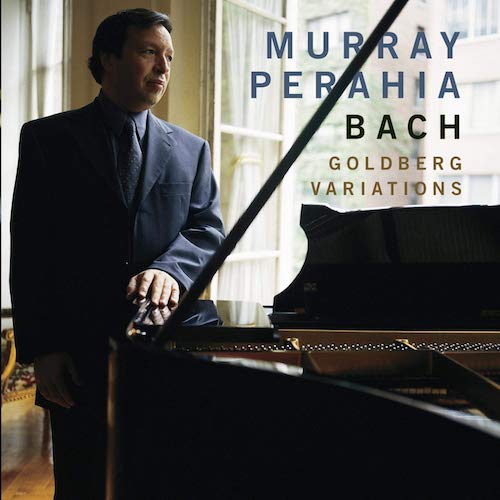
András Schiff (ECM):
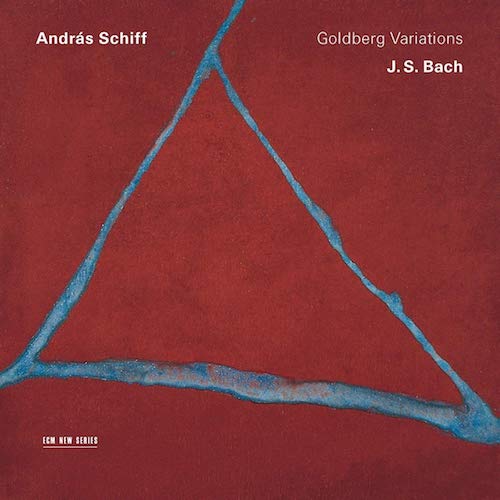
Klára Würtz:
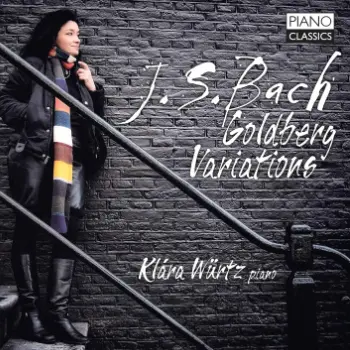
Ekaterina Dershavina:
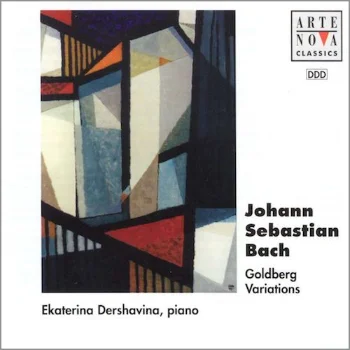
This concludes our definitive guide to the best recordings of Bach’s Goldberg Variations. What did you think about our recommendation for Harpsichord and Piano? Share this guide or tell us in the comments. Also, don’t forget to sign up for our classical music newsletter to be updated once new guides are published.
Cover photo by Geert Pieters on Unsplash
Available on Presto
Included with an Apple Music subscription:
Latest Classical Music Posts


